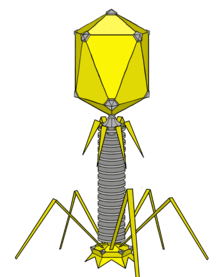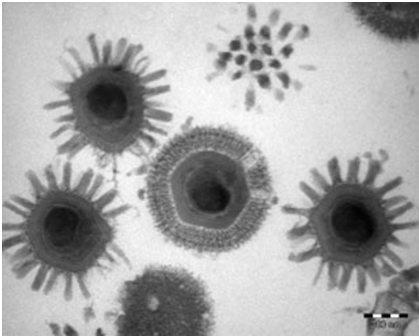The field of virology (inclusive of medical virology, plant virology and veterinary virology) blossomed following the discovery and development of transmission electron microscopy (TEM). Virology as a field in the biological sciences has spanned over 200 years; and this important discipline has continued to remain relevant to mankind and its environment owing to the varying economic importance of viruses. Mankind has lived with the negative effects of viruses especially in the ability of these small infectious agents to cause devastating diseases (e.g. measles, poliomyelitis and smallpox).
Measles (caused by measles virus) for example is one viral infection that ravaged humanity worldwide causing high mortality rate in children; and the disease is characterized by reddish rash that covers the whole body. Though smallpox have been eradicated worldwide inclusive of measles; poliomyelitis is yet to be fully eradicated in some countries; and there exist vaccines that are used for the prevention of these viral diseases in children. The existence of very small infectious particles or agents too small to be seen by the light microscope and that were able to cause disease in man, plants and animals was long hypothesized by scientists since time immemorial (especially between the 18th to 19th century) even though these disease agents was not actually given a name as at the time.
It was discovered as at the time that there exist infectious disease agents (in this case: viruses) that were capable of passing through filters that were very small enough to hold back all infectious agents including the smallest bacteria. These filterable infectious agents were later called “virus” to mean “poisonous liquid” in Latin. Vaccination (which is the medical process of immunizing a host (man or animal) against an infectious disease by injecting it with substances (i.e. vaccines) that contain antigens to a particular disease so that the host’s body could build up or develop protective antibodies in advance) actually developed from the study of viruses.
Today, there are many infectious diseases (including those caused by viruses and bacteria) that humans and animals can be vaccinated against; and this singular process of preventing diseases in advance i.e. before they occur has saved countless number of humans and animals as well from many killer diseases. Vaccination has contributed a lot to humanity in terms of the relief it gives man from infectious disease; and this one aspect gives impetus to the economic importance of virus aside the fact that they cause significant number of diseases in man, plants and animals. Some of the commonly used vaccines that are of viral origin and are used in clinical medicine are shown in Table 1.
As at the time that smallpox was ravaging humanity, it was discovered that those who survived the disease outbreak were inoculated with smallpox crusts or pustules; and this singular practice generally known as variolation protected susceptible individuals from contracting smallpox disease. In China precisely (around 1000 BC, smallpox was highly endemic and they used this concept of variolation to protect susceptible persons from smallpox infection.
Variolation is an old or prehistoric practice used by some cultures to protect people from smallpox infection; and it mainly involves the inoculation of susceptible people with smallpox lesions in order to prevent them from contracting the smallpox disease. Variolation is a primitive type of the modern-day vaccination; and the principles of immunization draw its concept or foundation from this obsolete mode of disease prevention.
Table 1. Some commonly used vaccines (of viral origin) in clinical medicine
| Vaccine | Preventable Disease |
| Hepatitis B | Hepatitis B infection |
| Measles | Measles infection |
| Yellow fever | Yellow fever infection |
| Polio | Poliomyelitis |
| Rotavirus | Rotavirus infection |
| Hepatitis A | Hepatitis A infection |
| Rabies | Rabies infection |
| Varicella | Varicella infection |
| Rubella | Rubella infection |
| Smallpox | Smallpox infection |
| Mumps | Mump infection |
In 1796, a notable scientist known as Edward Jenner (1749-1823) discovered that cow maids infected with the cowpox virus were naturally immune to smallpox infection; and this observation impelled Jenner (a recipient of variolation) into discovering the reason behind this and thus he inoculated humans with cowpox pustules, an act that protected people from smallpox infection as at the time. Jenner inoculated a 13 year old boy with vaccinia virus obtained from a young woman infected with cowpox; and this microbial challenge protected the young lad from smallpox infection.
Dmitri Iwanovski (1864-1920) showed in 1892 that leaf extracts from infected plants could cause disease in healthy plants even after filtration. Dmitri Iwanovski, a Russian bacteriologist attempted to establish the cause of tobacco mosaic disease in 1892 by filtering the sap of diseased tobacco plants through a porcelain filter that was designed to retain bacteria. Scientists in time past had shown that the tobacco mosaic disease could be transmitted from a diseased plant to a healthy plant. To the surprise of Dmitri the infectious agent in the sap of diseases tobacco plants passed through the small pores of the porcelain filter.
The healthy tobacco plant came down with tobacco mosaic disease when the infectious sap filtrate was injected into it. Iwanovski called this filterable infectious disease agent a toxin. Dmitri Iwanovski then concluded that the infectious agent responsible for the tobacco mosaic disease was an organism or toxin small enough to pass through the small pores of the porcelain filter. This filterable infectious agent that affected plants was later called tobacco mosaic disease virus by Martinus Beijerinck (1851-1931) and his colleagues who in 1898 confirmed the work of Dmitri Iwanovski on plant disease that could be transmitted to healthy plants.
Martinus hypothesized that the tobacco mosaic disease in plants was caused by a filterable virus (an infectious particle different from bacteria) since the filtered sap of the diseased plant remained infectious after passing through filters that held back bacteria. They determined that the behavior of the infectious agent causing tobacco mosaic disease in the tobacco plants was different from that of bacteria. And that this infectious particle or agent could only survive inside a living host cell but survive in an inactive state outside living cells. The tobacco mosaic virus was finally isolated in pure form in 1935 by Wendell M. Stanley.
Wendell was the first to establish the chemical nature of viruses; and this was achieved when he showed in the early 1930s through advanced techniques that the tobacco mosaic virus (TMV) is mainly made up of protein molecules. It was later that scientists (particularly Frederick Bawden and Norman Pirie) showed that the TMV does not just contain proteins but nucleic acids. And this was later confirmed in the 1930s following the discovery of the electron microscope that viruses are infectious particles or agents that are made up of proteins and nucleic acids.In 1900, Reed Walter (1851-1902), a U.S army physicianshowed in 1898 that yellow fever was caused by a virus transmitted via mosquitoes to humans.And this was the firstdiscovery that viruses could be transmitted via insect vectors.
Another milestone in virology was unraveled when in 1915, Frederick William Twort (1877-1950) showed that bacteria could be attacked or infected by virus; and these bacterial viruses were later known as bacteriophages or phages. Viruses that attack Archaea also exist and they are known as archaeal viruses. Archaealviruseswhich are mainly DNA-containing virions include those that affect or infect members of the Euryarchaeota and Crenarchaeota families; and no RNA viruses have so far been discovered to infect the Archaea.The DNA genome of the Archaeal viruses is double stranded; and the structure of the virions generally known as the Archaeal viruses is unusual and different from the normal structures of other virions that affect the prokaryotes and eukaryotes.
Notably, most Archaeal viruses assume a spindle-like structure that resembles that of the T4 bacteriophage. The term “bacteriophage” was actually coined by Felix d’Herelle (1873-1949) who used bacteriophage or phage therapy to treat some bacterial related diseases (e.g. cholera, bubonic plague, dysentery, streptococcal and staphylococcal infections) as at the time. This serendipitous discovery of bacteriophages by Felix was noted when he observed that his Shigella cultures were surrounded by plaque-forming agent or filterable virus that encircled the growing bacterial cells on the culture plate. And he later showed that bacteriophages could eat holes in bacterial lawns and that they only reproduce within living cells. Thus the discovery of bacteriophages was largely accredited to both Twort and d’Herelle who worked independently to discover these bacterial eating viruses known as phages.
Many viruses have since been discovered especially the human immunodeficiency virus (HIV) that causes AIDS and have ravaged humanity since its discovery in 1983. Though several studies are underway to find a cure for this world epidemic (AIDS), there is still no permanent cure or vaccine against the dreaded disease. And the reality of AIDS amongst other viral diseases has continued to shed more light on the field of virology which studies viruses. However, several breakthroughs in the field of virology especially in the discovery of potent vaccines and therapeutics as well as the discovery and development of the transmission electron microscope in the early 1930’s has given impetus to the relevance of this subject in our world of today.
References
Acheson N.H (2011). Fundamentals of Molecular Virology. Second edition. John Wiley and Sons Limited, West Sussex, United Kingdom.
Alan J. Cann (2005). Principles of Molecular Virology. 4th edition. Elsevier Academic Press, Burlington, MA, USA.
Alberts B, Bray D, Johnson A, Lewis J, Raff M, Roberts K and Walter P (1998). Essential Cell Biology: An Introduction to the Molecular Biology of the Cell. Third edition. Garland Publishing Inc., New York.
Barrett J.T (1998). Microbiology and Immunology Concepts. Philadelphia, PA: Lippincott-Raven Publishers. USA.
Black, J.G. (2008). Microbiology: Principles and Explorations (7th ed.). Hoboken, NJ: J. Wiley & Sons.
Brian W.J Mahy and Mark H.C van Regenmortel (2010). Desk Encyclopedia of Human and Medical Virology. Elsevier Academic Press, San Diego, USA.
Brooks G.F., Butel J.S and Morse S.A (2004). Medical Microbiology, 23rd edition. McGraw Hill Publishers. USA.
Cann A.J (2011). Principles of Molecular Virology. Fifth edition. Academic Press, San Diego, United States.
Carter J and Saunders V (2013). Virology: Principles and Applications. Second edition. Wiley-Blackwell, New Jersey, United States.
Champoux J.J, Neidhardt F.C, Drew W.L and Plorde J.J (2004). Sherris Medical Microbiology: An Introduction to Infectious Diseases. 4th edition. McGraw Hill Companies Inc, USA.
Dimmock N (2015). Introduction to Modern Virology. Seventh edition. Wiley-Blackwell, New Jersey, United States.
Dimmock N.J, Easton A.J and Leppard K.N (2001). Introduction to modern virology. 5th edition. Blackwell Science publishers. Oxford, UK.
Discover more from #1 Microbiology Resource Hub
Subscribe to get the latest posts to your email.



